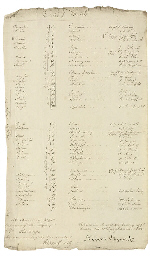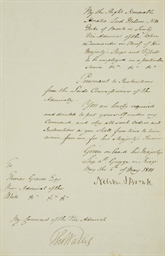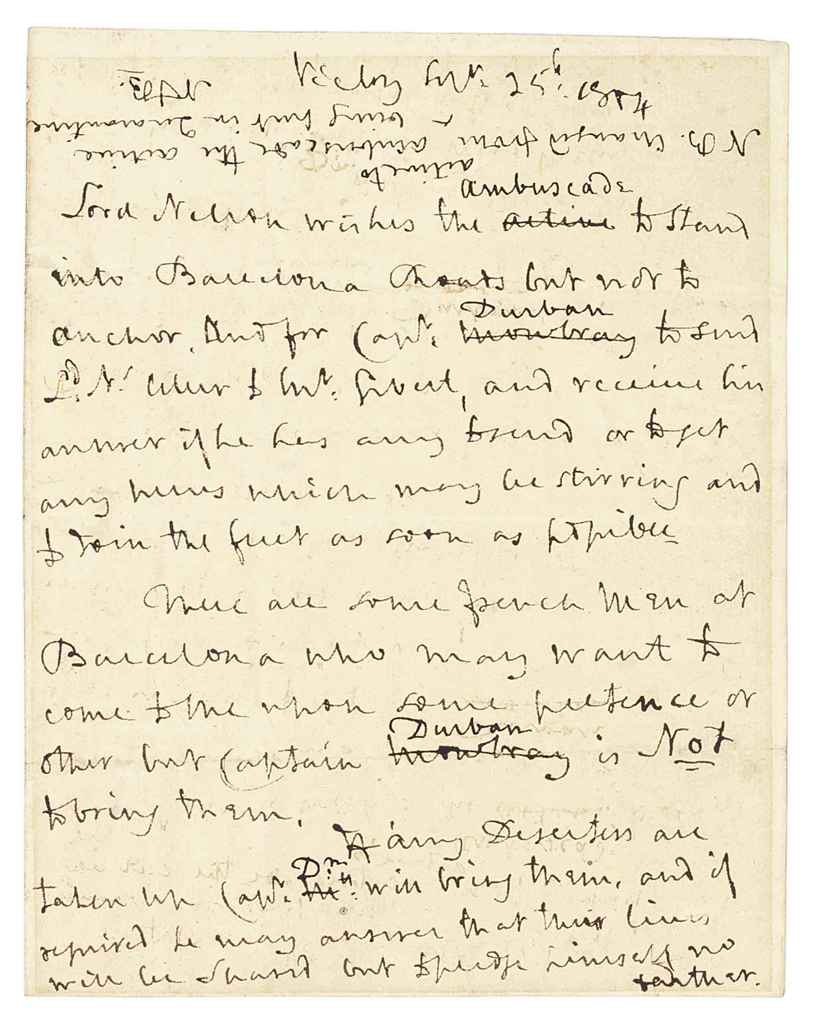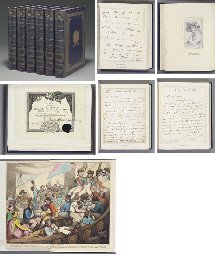NELSON, Horatio, Viscount (1758-1805). Document signed ('Nelson & Bronte'), THE 'ORDER OF SAILING' FOR THE BATTLE OF TRAFALGAR, Victory off Cadiz, 10 October 1805, this copy for Robert Moorsom, Captain of the Revenge , the vessels listed in four columns, comprising 'Van or Starboard division. Vanes at the Main' (two divisions), 'Rear or Larboard division. Vanes at the fore' (two divisions), with, to the left of each, 'Frigates Sloops &c wearing the same Vanes', the ships of the line numbered (20 in each principal division, no names given against nos 5, 15 and 19 in the Van Division and 17 in the Rear Division) and the pennants for each ship of the line (except for the flagship, Victory ) coloured in watercolour, one page, oblong folio (330 x 193mm) (wear especially at left and right margins, with a number of tears, soiling at right margin, a few minor stains), some pencil annotations (underlinings, noting the number of guns to each ship, adding the name of the Africa , 14th in the Rear Division). Provenance : Admiral Sir Robert Moorsom, KCB; and by descent. The 'Order of Sailing' was issued on the day after Nelson's decisive 'Trafalgar Orders', in which he had set out his plan for the coming battle, and which refers specifically to the order of sailing as being synonymous with the order of battle: 'Thinking it almost impossible to bring a Fleet of Forty sail of the Line into a Line of Battle in variable Winds thick Weather and other Circumstances which must occur ... I have therefore made up my mind to keep the Fleet in that position of Sailing (with the exception of the first and second in command) that the Order of Sailing is to be the Order of Battle'. In the event, the 'Order of Sailing' does not exacty represent the order in which the two columns of the British fleet attacked at Trafalgar: most famously, while the present document places the commanders of the two divisions, in Victory and Royal Sovereign , third in their respective lines, Nelson and Collingwood chose to enter battle first. But other contingencies affected the battle line: most obviously, a number of ships (underlined in pencil in the present document) were absent from the fleet for various purposes at the time of the battle. Finally, Nelson's fleet was unwilling to sacrifice time to unnecessary manoeuvres in the light winds prevailing on 21 October, and, in the words of William Badcock, a midshipman on the Neptune , 'the line never was properly formed, for the brave and gallant chiefs of each division were too eager to get into battle to wait for this'. The Revenge was a brand-new ship at Trafalgar, having been commissioned only in April 1805 under Captain Robert Moorsom; she was one of the first ships to be painted with Nelson's distinctive 'chequer' -- that is, a black hull, a yellow stripe along each row of gun-ports, and the gun ports themselves black. She was in the lee column at the battle of Trafalgar: 'In attempting to pass through the enemy's line and secure an advantageous position athwart the hawser of the French [ Achille ], she fouled the latter's jib-boom, and while the ships were interlocked delivered a couple of broadsides into the Frenchman's bows. Then, standing on, she was in the act of hauling up on the port tack, when a tremendous fire was poured into her lee quarter by the Spanish Principe de Asturias . Three two-deckers also hemmed her in, and greatly punished her until they were driven off by the approach of other British vessels. Her injuries in the battle were in consequence severe and her losses heavy, the latter amounting to twenty-eight killed and fifty-one wounded, including her captain' (Colonel R.H. Mackenzie, The Trafalgar Roll (2004), pp.103-4). The Revenge's captain, Yorkshireman Robert Moorsom (1760-1835) was later Lord Commissioner of the Admiralty and Commander-in-Chief, Chatham.
NELSON, Horatio, Viscount (1758-1805). Document signed ('Nelson & Bronte'), THE 'ORDER OF SAILING' FOR THE BATTLE OF TRAFALGAR, Victory off Cadiz, 10 October 1805, this copy for Robert Moorsom, Captain of the Revenge , the vessels listed in four columns, comprising 'Van or Starboard division. Vanes at the Main' (two divisions), 'Rear or Larboard division. Vanes at the fore' (two divisions), with, to the left of each, 'Frigates Sloops &c wearing the same Vanes', the ships of the line numbered (20 in each principal division, no names given against nos 5, 15 and 19 in the Van Division and 17 in the Rear Division) and the pennants for each ship of the line (except for the flagship, Victory ) coloured in watercolour, one page, oblong folio (330 x 193mm) (wear especially at left and right margins, with a number of tears, soiling at right margin, a few minor stains), some pencil annotations (underlinings, noting the number of guns to each ship, adding the name of the Africa , 14th in the Rear Division). Provenance : Admiral Sir Robert Moorsom, KCB; and by descent. The 'Order of Sailing' was issued on the day after Nelson's decisive 'Trafalgar Orders', in which he had set out his plan for the coming battle, and which refers specifically to the order of sailing as being synonymous with the order of battle: 'Thinking it almost impossible to bring a Fleet of Forty sail of the Line into a Line of Battle in variable Winds thick Weather and other Circumstances which must occur ... I have therefore made up my mind to keep the Fleet in that position of Sailing (with the exception of the first and second in command) that the Order of Sailing is to be the Order of Battle'. In the event, the 'Order of Sailing' does not exacty represent the order in which the two columns of the British fleet attacked at Trafalgar: most famously, while the present document places the commanders of the two divisions, in Victory and Royal Sovereign , third in their respective lines, Nelson and Collingwood chose to enter battle first. But other contingencies affected the battle line: most obviously, a number of ships (underlined in pencil in the present document) were absent from the fleet for various purposes at the time of the battle. Finally, Nelson's fleet was unwilling to sacrifice time to unnecessary manoeuvres in the light winds prevailing on 21 October, and, in the words of William Badcock, a midshipman on the Neptune , 'the line never was properly formed, for the brave and gallant chiefs of each division were too eager to get into battle to wait for this'. The Revenge was a brand-new ship at Trafalgar, having been commissioned only in April 1805 under Captain Robert Moorsom; she was one of the first ships to be painted with Nelson's distinctive 'chequer' -- that is, a black hull, a yellow stripe along each row of gun-ports, and the gun ports themselves black. She was in the lee column at the battle of Trafalgar: 'In attempting to pass through the enemy's line and secure an advantageous position athwart the hawser of the French [ Achille ], she fouled the latter's jib-boom, and while the ships were interlocked delivered a couple of broadsides into the Frenchman's bows. Then, standing on, she was in the act of hauling up on the port tack, when a tremendous fire was poured into her lee quarter by the Spanish Principe de Asturias . Three two-deckers also hemmed her in, and greatly punished her until they were driven off by the approach of other British vessels. Her injuries in the battle were in consequence severe and her losses heavy, the latter amounting to twenty-eight killed and fifty-one wounded, including her captain' (Colonel R.H. Mackenzie, The Trafalgar Roll (2004), pp.103-4). The Revenge's captain, Yorkshireman Robert Moorsom (1760-1835) was later Lord Commissioner of the Admiralty and Commander-in-Chief, Chatham.
NELSON, Horatio, Viscount (1758-1805). Document signed ('Nelson & Bronte'), THE 'ORDER OF SAILING' FOR THE BATTLE OF TRAFALGAR, Victory off Cadiz, 10 October 1805, this copy for Robert Moorsom, Captain of the Revenge , the vessels listed in four columns, comprising 'Van or Starboard division. Vanes at the Main' (two divisions), 'Rear or Larboard division. Vanes at the fore' (two divisions), with, to the left of each, 'Frigates Sloops &c wearing the same Vanes', the ships of the line numbered (20 in each principal division, no names given against nos 5, 15 and 19 in the Van Division and 17 in the Rear Division) and the pennants for each ship of the line (except for the flagship, Victory ) coloured in watercolour, one page, oblong folio (330 x 193mm) (wear especially at left and right margins, with a number of tears, soiling at right margin, a few minor stains), some pencil annotations (underlinings, noting the number of guns to each ship, adding the name of the Africa , 14th in the Rear Division). Provenance : Admiral Sir Robert Moorsom, KCB; and by descent. The 'Order of Sailing' was issued on the day after Nelson's decisive 'Trafalgar Orders', in which he had set out his plan for the coming battle, and which refers specifically to the order of sailing as being synonymous with the order of battle: 'Thinking it almost impossible to bring a Fleet of Forty sail of the Line into a Line of Battle in variable Winds thick Weather and other Circumstances which must occur ... I have therefore made up my mind to keep the Fleet in that position of Sailing (with the exception of the first and second in command) that the Order of Sailing is to be the Order of Battle'. In the event, the 'Order of Sailing' does not exacty represent the order in which the two columns of the British fleet attacked at Trafalgar: most famously, while the present document places the commanders of the two divisions, in Victory and Royal Sovereign , third in their respective lines, Nelson and Collingwood chose to enter battle first. But other contingencies affected the battle line: most obviously, a number of ships (underlined in pencil in the present document) were absent from the fleet for various purposes at the time of the battle. Finally, Nelson's fleet was unwilling to sacrifice time to unnecessary manoeuvres in the light winds prevailing on 21 October, and, in the words of William Badcock, a midshipman on the Neptune , 'the line never was properly formed, for the brave and gallant chiefs of each division were too eager to get into battle to wait for this'. The Revenge was a brand-new ship at Trafalgar, having been commissioned only in April 1805 under Captain Robert Moorsom; she was one of the first ships to be painted with Nelson's distinctive 'chequer' -- that is, a black hull, a yellow stripe along each row of gun-ports, and the gun ports themselves black. She was in the lee column at the battle of Trafalgar: 'In attempting to pass through the enemy's line and secure an advantageous position athwart the hawser of the French [ Achille ], she fouled the latter's jib-boom, and while the ships were interlocked delivered a couple of broadsides into the Frenchman's bows. Then, standing on, she was in the act of hauling up on the port tack, when a tremendous fire was poured into her lee quarter by the Spanish Principe de Asturias . Three two-deckers also hemmed her in, and greatly punished her until they were driven off by the approach of other British vessels. Her injuries in the battle were in consequence severe and her losses heavy, the latter amounting to twenty-eight killed and fifty-one wounded, including her captain' (Colonel R.H. Mackenzie, The Trafalgar Roll (2004), pp.103-4). The Revenge's captain, Yorkshireman Robert Moorsom (1760-1835) was later Lord Commissioner of the Admiralty and Commander-in-Chief, Chatham.
NELSON, Horatio, Viscount (1758-1805). Document signed ('Nelson & Bronte'), THE 'ORDER OF SAILING' FOR THE BATTLE OF TRAFALGAR, Victory off Cadiz, 10 October 1805, this copy for Robert Moorsom, Captain of the Revenge , the vessels listed in four columns, comprising 'Van or Starboard division. Vanes at the Main' (two divisions), 'Rear or Larboard division. Vanes at the fore' (two divisions), with, to the left of each, 'Frigates Sloops &c wearing the same Vanes', the ships of the line numbered (20 in each principal division, no names given against nos 5, 15 and 19 in the Van Division and 17 in the Rear Division) and the pennants for each ship of the line (except for the flagship, Victory ) coloured in watercolour, one page, oblong folio (330 x 193mm) (wear especially at left and right margins, with a number of tears, soiling at right margin, a few minor stains), some pencil annotations (underlinings, noting the number of guns to each ship, adding the name of the Africa , 14th in the Rear Division). Provenance : Admiral Sir Robert Moorsom, KCB; and by descent. The 'Order of Sailing' was issued on the day after Nelson's decisive 'Trafalgar Orders', in which he had set out his plan for the coming battle, and which refers specifically to the order of sailing as being synonymous with the order of battle: 'Thinking it almost impossible to bring a Fleet of Forty sail of the Line into a Line of Battle in variable Winds thick Weather and other Circumstances which must occur ... I have therefore made up my mind to keep the Fleet in that position of Sailing (with the exception of the first and second in command) that the Order of Sailing is to be the Order of Battle'. In the event, the 'Order of Sailing' does not exacty represent the order in which the two columns of the British fleet attacked at Trafalgar: most famously, while the present document places the commanders of the two divisions, in Victory and Royal Sovereign , third in their respective lines, Nelson and Collingwood chose to enter battle first. But other contingencies affected the battle line: most obviously, a number of ships (underlined in pencil in the present document) were absent from the fleet for various purposes at the time of the battle. Finally, Nelson's fleet was unwilling to sacrifice time to unnecessary manoeuvres in the light winds prevailing on 21 October, and, in the words of William Badcock, a midshipman on the Neptune , 'the line never was properly formed, for the brave and gallant chiefs of each division were too eager to get into battle to wait for this'. The Revenge was a brand-new ship at Trafalgar, having been commissioned only in April 1805 under Captain Robert Moorsom; she was one of the first ships to be painted with Nelson's distinctive 'chequer' -- that is, a black hull, a yellow stripe along each row of gun-ports, and the gun ports themselves black. She was in the lee column at the battle of Trafalgar: 'In attempting to pass through the enemy's line and secure an advantageous position athwart the hawser of the French [ Achille ], she fouled the latter's jib-boom, and while the ships were interlocked delivered a couple of broadsides into the Frenchman's bows. Then, standing on, she was in the act of hauling up on the port tack, when a tremendous fire was poured into her lee quarter by the Spanish Principe de Asturias . Three two-deckers also hemmed her in, and greatly punished her until they were driven off by the approach of other British vessels. Her injuries in the battle were in consequence severe and her losses heavy, the latter amounting to twenty-eight killed and fifty-one wounded, including her captain' (Colonel R.H. Mackenzie, The Trafalgar Roll (2004), pp.103-4). The Revenge's captain, Yorkshireman Robert Moorsom (1760-1835) was later Lord Commissioner of the Admiralty and Commander-in-Chief, Chatham.







.jpg)







Testen Sie LotSearch und seine Premium-Features 7 Tage - ohne Kosten!
Lassen Sie sich automatisch über neue Objekte in kommenden Auktionen benachrichtigen.
Suchauftrag anlegen